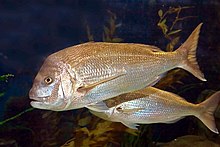Kahungunu
In his old age, he negotiated a peace when Maunga-a-kāhia was attacked by his nephew Tūtāmure and he summoned the war party which avenged his son at the Battle of Kai-whakareireia.
After his birth, Tamatea buried Kahungunu's umbilical cord nearby with three whatu-kura (sacred stones), so that it would be an iho-whenua, a link which would bind the land to him.
[5] Hare Hongi reports a traditional saying about him: Ko Kahungunu he tangata ahuwhenua; mōhio ki te haere i ngā mahi o uta, me o te tai ("Kahungunu is an industrious man, who knows how to manage works, both on land and at sea") and notes his expertise at village-planning, farming, bird hunting, wood carving, tattooing, flax-weaving, canoe-making, navigation, fishing, and collection of shellfish.
Te Whaene angrily threw a tāmure fish (snapper) at Kahungunu, injuring his hand.
Kahungunu therefore travelled to his sister Haumanga and her husband Tunanui Haruatai at Ōpōtiki and asked for men so that he could lead a war party (taua) against Te Whaene and get revenge.
Shortly after this, his sister gave birth to a son, whom Kahungunu named Tūtāmure ("snapper wound") in commemoration of his quarrel with Te Whaene.
[7] Kahungunu travelled on to East Cape, where he came to the village of Popoia on the Waipaoa River, home of Ruapani (a descendant of Pawa and Kiwa).
[8] After this, Kahungunu travelled to Whareongaonga Bay (near Young Nick's Head), where he fell in love with Hine-puariari, daughter of Panui, and married her.
When Rongomai-wahine heard a comment that Hine-puariari had made after marrying Kahungunu: kāore hoki tērā te hanga o tāku tane, kāore e rūpeke mai ana, takoto noa mai te nuinga i waho ("the remarkable thing is that my husband's thing wouldn't fit!
"), she said Nā te mea anō rā he kōpua pāpaku, mehemea e taka mai ana ki te kōpua hōhonu a Rapa e tuhera atu nei, pokopoko ana ia ki roto ("that's because it is a shallow pool; if it had fallen into the deep pool of Rapa now opening towards him, it would have been lost out of sight").
[10] On arrival, Kahungunu demonstrated his prowess by leading an expedition to gather aruhe (fern root) in the hills.
He dove down underwater with a kāwhiu basket on the end of a rope, filling it repeatedly, while the other members of the expedition hauled it up, emptied it, and threw it back to him.
[12] The next day, Kahungunu found Tama-taku-tai at the beach, practicing whakaheke ngaru (riding the breaking waves in his canoe, somewhat like surfing).
Around 1475, when Kahungunu was an old man, his nephews Tūtāmure and Tamataipūnoa led a force of five hundred men to attack Maunga-a-kāhia.
[15] Kahungunu's son Tuaiti had married Moetai daughter of Moeahu and settled at Rurutawhao at Aranui (near Frasertown).
[27] Kahungunu is the tiki carved on the koruru (gable) of the Takitimu wharenui at Waihīrere marae built at Wairoa in 1926.



